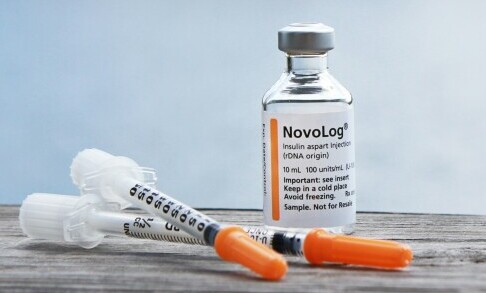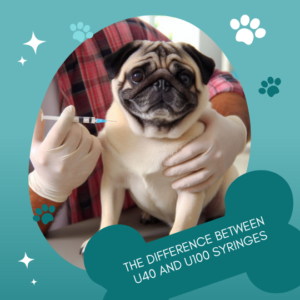U40 insulin syringes are designed for insulin with a lower concentration of 40 units per milliliter. These are typically used for veterinary purposes. On the other hand, U100 insulin syringes are for insulin that has a concentration of 100 units per milliliter, which is most common for human use. The key difference is that U40 syringes have fewer insulin units per milliliter, making the dosage markings different from U100 syringes.

U40 insulin is not available in Ukraine, so when Brady was first diagnosed, we were not briefed on the differences in the syringes, what to look for to be sure we were using the correct syringe, or the dangers of getting the wrong one. When we returned to the USA for a year, we were already taking care of our diabetic dog. Our vet here did not think to give us the new -diagnosis talk. We made the mistake of ordering “pet insulin” syringes without realizing what we were doing.
Visually, U40 and U100 syringes are quite distinct. I’ve learned that U40 syringes usually have red markings, while U100 syringes have orange markings. This color-coding helps users quickly distinguish between them. Generally, U100 syringes have finer needles because they are designed for more frequent use in human insulin therapy. However, the primary difference is the calibrations and the color coding.
We didn’t know to pay attention to the color. When the syringes arrived, they looked bigger to me. I went to my local pharmacist and he dismissively told me that 5 units was 5 units. Unfortunately, I trusted that he knew what he was talking about. I know now, I had U40 syringes.
Using the wrong type of syringe for the insulin you have can lead to dangerous dosage errors. Suppose you use a U100 syringe with U40 insulin. In that case, you’ll likely end up with an underdose because the syringe is calibrated for more concentrated insulin, meaning you need less fluid in the syringe.
Underdosing a diabetic dog can lead to significant health risks, as the dog’s body may not receive enough insulin to regulate blood glucose levels. The most immediate consequence of underdosing is high blood sugar or hyperglycemia. and the most obvious symptom of hypoglycemia is drinking and peeing a lot. Over time underdosing leads to weight loss, organ damage, weakness, and generally a poor quality of life. In severe cases, your dog could develop life-threatening Diabetic ketoacidosis. However, if you pay attention, underdosing is usually not immediately dangerous.
Conversely, using a U40 syringe with U100 insulin can result in an overdose since the syringe is designed to hold more fluid with a lower concentration of insulin. In this case, the wrong syringe will administer more insulin than intended. Overdosing a diabetic dog on insulin is immediately dangerous and leads to low blood sugar or hypoglycemia. Low blood sugar can cause the dog to become unusually tired, weak, or unresponsive. Your dog may start shaking due to a lack of glucose in the bloodstream. They might appear confused, have difficulty walking, or display other signs of disorientation. In severe cases, the dog can experience seizures, which may require immediate medical intervention. If untreated, hypoglycemia can lead to coma and, in severe cases, can be fatal.
What to Do in Case of an Insulin Overdose
- Feed the Dog: Offer food with sugar, such as honey or corn syrup, to help raise blood sugar levels quickly.
- Seek Emergency Vet Care: Contact a veterinarian immediately.
We were on a camping trip when Brady had a seizure. He was lying in the camper with me when he just started twitching. We gave him some honey and immediately headed to the closest veterinarian. He was very low, but the vet was able to get his sugar level up quickly enough that he was fine within a few hours. She filled me in on the issue with the syringes. (Yes, I did go back and say something to the pharmacist who was so dismissive. I should not have believed him…I couldn’t make it make sense, but I believed the professional rather than my own eyes. We were lucky.) I took the syringes I had to a pharmacy near our campground and bought new ones.

Accurate dosage is critical. Insulin dosage isn’t something to eyeball. The short-term and long-term effects are damaging. Double-check the insulin type and make sure you buy the corresponding syringe. Store insulin and syringes properly, and label them clearly to avoid any confusion. Always read labels carefully and maybe even develop a habit of cross-referencing the insulin with the syringes when you open a new box. Small steps like these can help keep your dog safe and healthy. If there’s any doubt, consulting a veterinarian or healthcare provider is the best idea to ensure safety and health.
Low blood sugar is scary. Learn from my mistake so you don’t have to go through it. Did your veterinarian give you this information? Please share your experiences in the comments.

